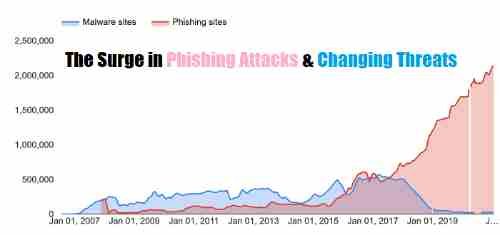Teleworking has become a more popular option than ever in 2020. The trend will continue into 2021. Teleworking will continue to be a standard work arrangement in any industry where it’s practical for the foreseeable future. See Also:4 Ways to Protect Your Customers Online
Remote work has unfortunately led to an increase of cybercrime. Hackers are acutely aware of the fact that devices connected to home networks are not as secure as devices linked to a corporate network.
Phishing: A new trend
Google announced in 2021 it had registered over 2,000,000 Phishing websites in 2020. This was a significant increase of more than 19% from 2019. It was also evident that phishing emails had increased in number, with criminals well aware of the COVID-19 potential.
Profiting from a Confused Public
Phishing is a very popular method because it is easy and it works. Even the most vigilant user can fall for phishing emails that seem convincing. It’s becoming easier for criminals and hackers to make these types of emails.
In 2020, new phishing emails included COVID-19 related subjects. These subjects included promising info about the pandemic, giving the possibility to donate to a charity, and taking advantage of the emotions raised by incendiary headlines.
Although the subjects were changed by fraudsters, they still sought the same data as in the past. They could use fraudulent websites to get donations, trick visitors into entering credentials or get malware installed on their devices.
No Signs that there will be a halt in 2021
Already there are no signs of phishing attacks going anywhere in 2021. Companies will continue to be subject to phishing campaigns that include general attacks against an entire company or spear-phishing attempts where they’re targeted at individuals.
Rising Threats & Concerns
The rise in ransomware is likely to continue into 2021. Ransomware often uses phishing and other attacks as its vector. A ransomware attack involves a cybercriminal requesting that someone download malicious code which encrypts sensitive data.
The criminals ask the organization to send money, usually in the form of cryptocurrency due to prices at an all-time high, to a bank account in order to decrypt their data. Ransomware will remain a problem as it is so profitable.
According to IBM, Sodinokibi, the most common ransomware group, made over $123 Million in profits in 2020. That’s quite a sum and one hacker will not be able to ignore it.
Deepfakes are a more persuasive way to attack
Deepfakes are another issue that will likely be more prevalent throughout the year. Deepfakes involve criminals using computer software and AI to create almost perfect digital copies of others, whether it’s in video or audio files.
Already, this technology has been used for evil. Criminals can re-create a CEO to convince employees or customers to trust a file or link. It’s a scary thought. And it shows no signs of abating. It’s not easy to fix.
What to do?
How can businesses deal with these cyberattacks that are increasingly sophisticated? Cyber, a small business that provides virtual CISOs to assist in developing a robust cybersecurity strategy, maybe a solution. Visit cybri.com to find them.
Phishing works only because the victims are not aware of its existence. While it is almost cliché to advocate more building awareness as a solution, it has to be done. It’s important to raise awareness about the sophistication of phishing attacks so that people don’t fall for it.
